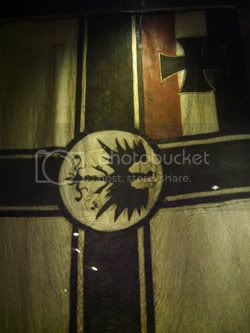Part 1 of the The Voyage of Seeadler
Within two days, von Luckner and his company of 6 Officers and 57 other men, were coping with a howling gale, which at least it helped to explain the soaked state of his log book etc, should they be stopped by a British blockade ship, and subsequently boarded for a routine inspection.
As part of the ploy to convince any British boarding party that his ship and crew were Norwegian, von Luckner had a slim young sailor masquerade as his wife, complete with a suitable blonde wig.
Come Christmas Day 1916, Seeadler having battled the elements for three days was south west of Greenland, when out of the rain a large ship appeared. It iturned out to be the British 15,000 ton Armed Merchant Cruiser, Avenger. She immediately signalled the sailing ship to heave to, and to await its boat carrying an inspection party.
All went well, and his ship's disguise proved successful, but at the last moment, as the two British Officers were about to leave the scene, von Luckner noticed with some trepidation that the Seeadler's propeller was very evident. His ship was purporting to only be a simple sailing vessel, so thinking and acting very quickly, von Luckner grabbed a rope and swung it towards the British boat, so that they could pull themselves forward. This distraction caused the Officers to focus their eyes on this rope, saving any embarrassment, and the propeller remained a secret.
Now the timber deck cargo covering up the hatches was ditched over the side, and Seeadler assumed her true role as a German Raider.
On the 9th of January 1917 Seeadler came upon a single-funneled steamer. She raised a signal requesting a time signal (not an uncommon thing for a sailing ship long out of contact with land to do), and too late for evasive action, raised the German ensign. Three shots were needed to persuade the 3,268 ton Gladys Royle, carrying coal from Cardiff to Buenos Aires, to stop. Her crew was taken off unharmed, and she was scuttled.
On 10 January 1917 Seeadler encountered another steamship which refused to identify itself. The German ensign was raised and a shot fired across the bow of the Lundy Island, carrying sugar from Madagascar. The steamer still refused to stop, and four shots were fired directly at her. The steamer hove to and lowered its boats, but its captain ignored an order to come to Seeadler. A German boarding party was sent over and discovered that the crew had abandoned ship when the first shots were fired, leaving the captain alone.
Later, Captain Bannister told Luckner that he had previously been captured by a German raider, and had given his parole which he had broken; thus he was not anxious to be a prisoner of war again.
Luckner continued his voyage southwards, and by 21 January he was in mid-Atlantic between Brazil and West Africa when he found the 2,199 ton French three-masted barque Charles Gounod, loaded with corn. Charles Gounod was quickly dispatched, but her log book recorded information about other ships she had met and their intended route.

This is a picture of the ensign von Luckner would raise on the Seeadler to convey hostile intent which is now on display at the Auckland War Memorial Museum.
Regards
Sean









